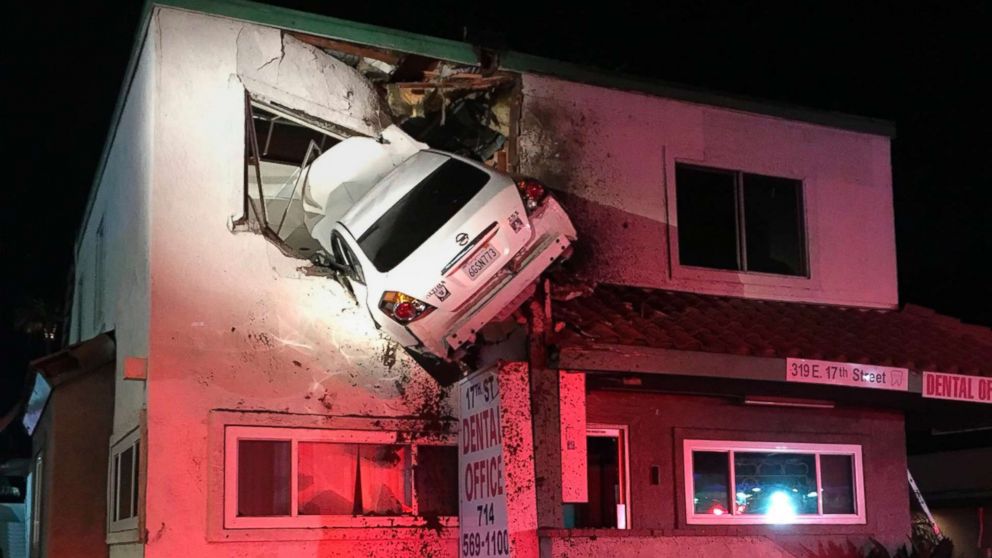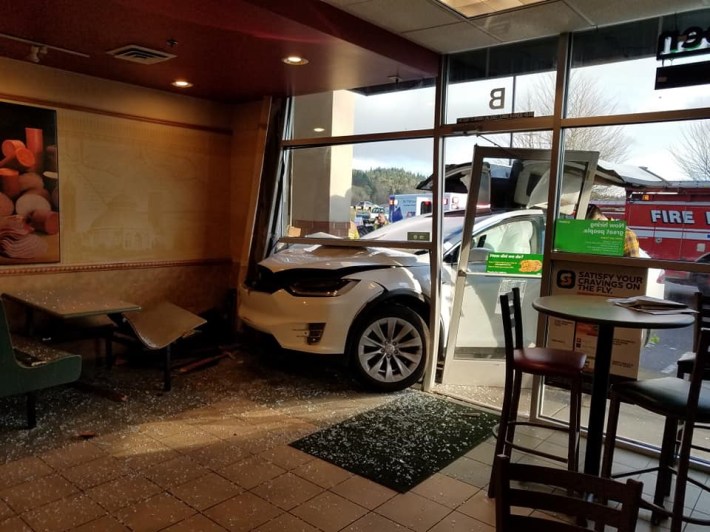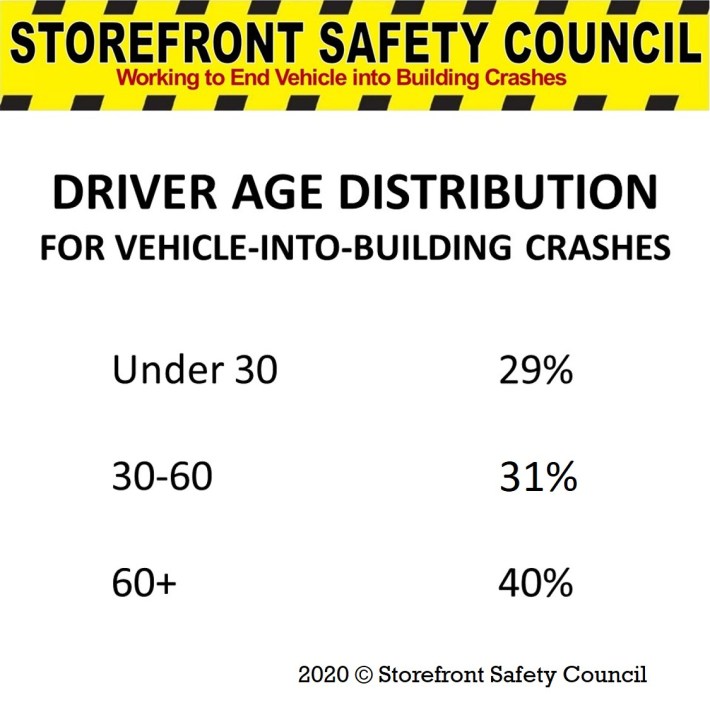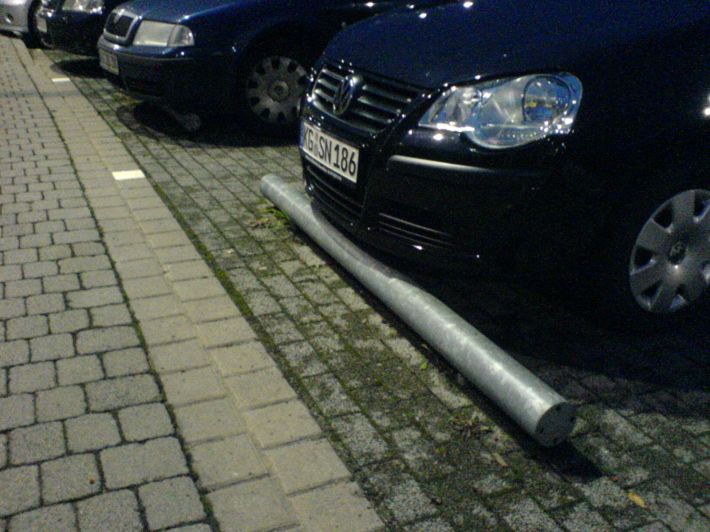Pedestrians Aren’t Even Safe From Car Crashes Inside Buildings
3:39 PM EST on February 19, 2020

Source: ABC News.
American pedestrians risk dying under the wheels of a car every time they cross an auto-centric street — but if you think walkers are safe from crashes once they step inside a building, think again.
Drivers crash their cars into buildings an astonishing 60 times per day on average — crashes that kill as many as 500 people every year, and injure at least 4,000 more, according to research from advocacy group the Storefront Safety Council. And most of these crashes aren’t the result of dramatic police chases or auto-assisted, smash-and-grab robberies; they’re the nearly inevitable side effect of car-dominated cities that insist on allowing automobiles to drive right up to the doorway of virtually every home, school and business.
Vehicle-into-building crashes, or VIBCs, are an even less talked-about phenomenon than roadway pedestrian fatalities — yet both kinds of crashes are 100 percent preventable. When it comes to ending VIBCs, even simple tweaks such as better building and parking lot design — along with efforts to reduce car dependency — could save lives and livelihoods.
But getting people to notice — much less, getting cities and building owners to take action — isn’t easy. Until they do, people will keep dying.
VIBCs: the silent killer of our traffic-violence crisis

Twenty years ago, vehicle-into-building crashes were a topic of concern for a sobering reason: post 9/11 terrorism fears. Preventing deliberate vehicle-ramming attacks and car bombs became a focus of federal anti-terrorism efforts as the car became a weapon among violent militant groups. Private companies across the country also took steps to protect their buildings from terrorists.
Rob Reiter, who went on to co-found the Storefront Safety Council, worked with these companies to outfit buildings with steel bollards and other security measures. But the longer he worked in the emerging industry, the more he realized just how many buildings weren’t protected from rogue drivers — and how relatively few VIBCs involved politically-motivated insurgents compared to distracted drivers.
“We were worried about power plants, international embassies, truck bombs outside of dignitaries’ homes, stuff like that,” Reiter said. “But meanwhile, vehicle-into-building crashes that were unintentional — along with crashes caused by anger, and by drunkenness — were killing way more people with cars than terrorists were.”
Those killings were no less horrific. As he began assembling crash reports, Reiter found that an average of 20 people were hit by cars while standing at walk-up ATMs in America every single month; crashes into schools, churches and offices were also shockingly common. Most VIBCs — 87 percent — happen in stores, restaurants, and other commercial spaces; in addition to deaths and injuries, employees in these cases were often put out of work for months at a time while buildings were repaired.
Who, Where and Why of VIBCs

As Reiter started digging into what lies behind the VIBC phenomenon, he found some surprising trends.
For one, many motorists involved in crashes are seniors; about 40 percent are older than 60. Reiter says many elderly drivers simply mistake the gas pedal for the brake — a phenomenon common enough to prompt endless "guess Grandma shouldn't be driving anymore!" jokes on sitcoms, but which Reiter says suggests a strong need for more stringent testing for older drivers, or anyone displaying visual, mental or physical impairments that could affect them behind the wheel.
But the other 60 percent of VIBCs involve younger drivers — and the reasons behind those crashes are often traceable to more familiar causes of roadway fatalities. The leading cause of VIBCs, at the Storefront Safety Council’s last count, was everyday operator error, excluding pedal misidentification, but including distracted driving; alcohol was involved in another 16 percent of crashes.
But what goes unspoken in these cause-of-accident stats, Reiter argues, is the role of design — specifically, the role of parking lot design.
Put simply, too many businesses either choose to or are required by law to build lots that put multi-ton vehicles directly outside of buildings — and to put far more of them than is necessary to accommodate customers with disabilities who use those vehicles as mobility aides. That means that when drivers are distracted, or impaired, or simply mistake the gas pedal for the brake, their cars have nowhere to go than over a tiny concrete wheel stop, across a thin strip of sidewalk, and directly into a storefront window.
That’s what happened to Storefront Safety Council co-founder Mark Wright. He was inside a Maryland 7-Eleven when an elderly driver crashed a car into the convenience store, throwing Wright 20 feet across the room and causing injuries that required nine months of recovery.

Reiter would like to see parking professionals re-think the kind of parking lot design that contributed to Wright’s crash: nose-in parking stalls that leave buildings with barely any protection. “Far more people are injured tripping over wheel stops rather than are actually protected by those things,” he says.
But big-box-style stacked parking stalls aren’t much better. “The bad news there is, you have these wide parking aisles that encourage drivers to go 20 miles an hour,” Reiter says. “Even if that car doesn’t hit the building — setting aside storefront safety for just a second — you’re still talking about a design that contributes to 50,000 parking lot [crashes] every year, and that injures 60,000 more people. And you know the people that are getting hurt usually aren’t the ones inside the cars — they’re the people walking back to their vehicles.”
How to build a better parking lot
So how can you design public space to keep drivers from killing people, even when they’re shopping inside a building? As a self-described “threat-based guy,” Reiter and his group are heavily focused on the kinds of interventions that he used in his career to keep truck bombs away from government buildings. Impact-resistant bollards and other barriers to guard doorways from scofflaw drivers are a necessary step, he says, although Reiter admits that costs can be prohibitive, and business owners “don’t like their stores and restaurants to look like fortresses.”
Traffic-directing signs and parking lot striping can signal drivers to slow down and stay in their lane — and out of the front lobby. But as any urban-planning nerd learns in How to Slow Down Cars 101, paint and signage are about the least effective things you can do to get drivers to hit the brakes — at least when compared to road features that compel them to be more careful. When it comes to designing parking lots that people won’t drive through like maniacs, the question of how to calm traffic gets harder — because lots, by their nature, have to have driving lanes wide enough to accommodate a Ford F-150 turning into a spot.
In the end, armoring every building in the nation with bumper-crushing bollards would help keep Americans from being crushed by cars while they’re indoors. But even if we did that — which is unlikely — it wouldn't answer the question of what happens when pedestrians step outside. Our real problem is a society that prioritizes car travel so much that we let people bring vehicles big enough to crush a brick wall within feet of preschools, nursing homes, libraries and homes. The prevalence of VIBC deaths should make us rethink car dominance itself — and not just whether we should put a guard rail in front of the grocery store.
Kea Wilson has more than a dozen years experience as a writer telling emotional, urgent and actionable stories that motivate average Americans to get involved in making their cities better places. She is also a novelist, cyclist, and affordable housing advocate. She previously worked at Strong Towns, and currently lives in St. Louis, MO. Kea can be reached at kea@streetsblog.org or on Twitter @streetsblogkea. Please reach out to her with tips and submissions.
Read More:
Stay in touch
Sign up for our free newsletter
More from Streetsblog USA
E-Bikes and Creating Financially Sustainable Bike Share Programs
The number of customers using bike share in the U.S. and Canada is now at an all-time high thanks to e-bikes.
Tuesday’s Headlines Pick the Low-Hanging Fruit
Greg Shill argues that if a transformative road redesign isn't possible, it's time to talk about second-best strategies.
How to Fight a Texas-Sized Freeway Battle
A new book explores how Texas advocates are fighting back against destructive highway expansions. But what happened to those projects since it was sent to the printer?
S.F. Fire Apologies for Tweeting About Imaginary Bike Rule
There is no rule in California that says cyclists have to ride single file — but the San Francisco Fire Department tweeted about it anyway.
You Wouldn’t Like Monday’s Headlines When They’re Angry
Which state has the worst road rage? Consumer Affairs magazine looked at a variety of factors to come up with an answer.





